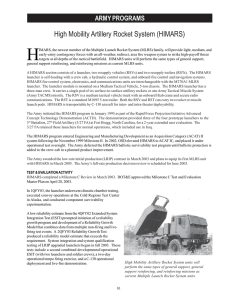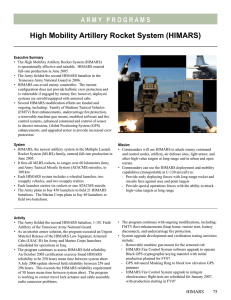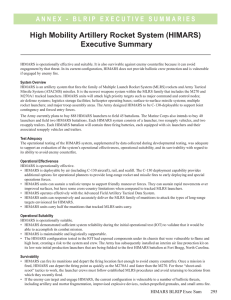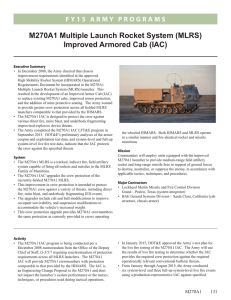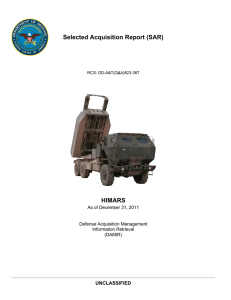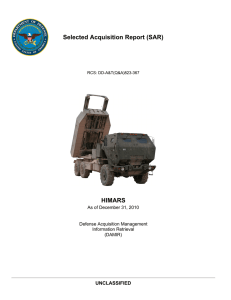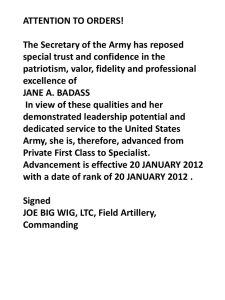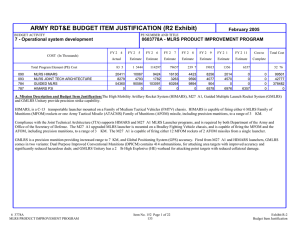High Mobility Artillery Rocket System (HIMARS)
advertisement
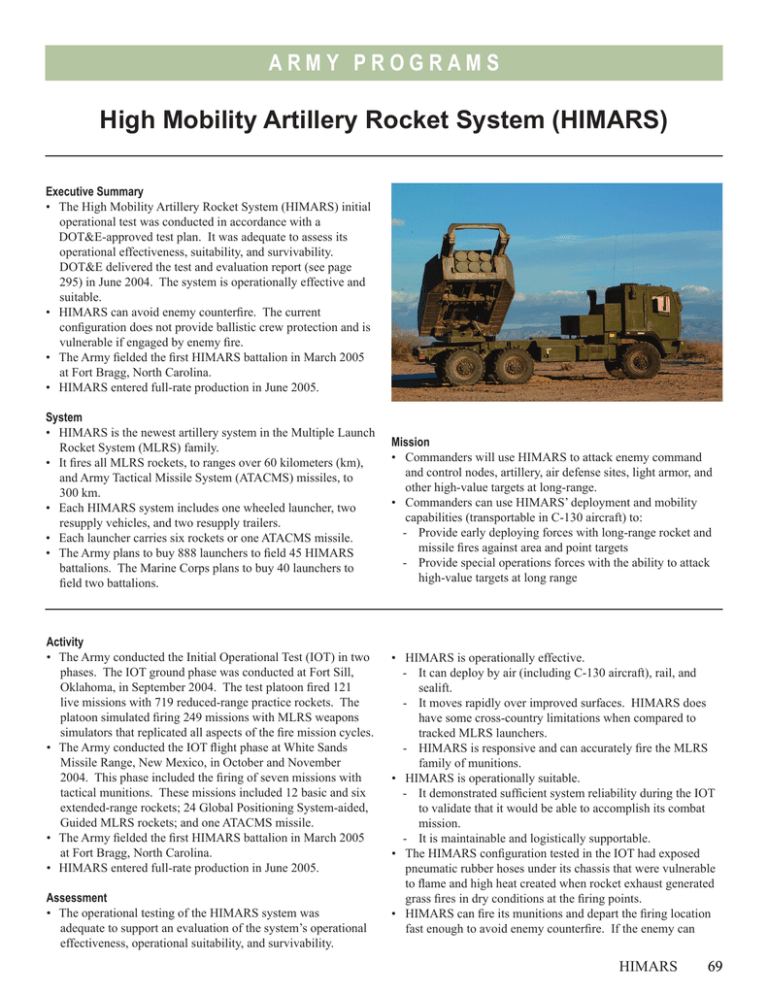
ARMY PROGRAMS High Mobility Artillery Rocket System (HIMARS) Executive Summary • The High Mobility Artillery Rocket System (HIMARS) initial operational test was conducted in accordance with a DOT&E-approved test plan. It was adequate to assess its operational effectiveness, suitability, and survivability. DOT&E delivered the test and evaluation report (see page 295) in June 2004. The system is operationally effective and suitable. • HIMARS can avoid enemy counterfire. The current configuration does not provide ballistic crew protection and is vulnerable if engaged by enemy fire. • The Army fielded the first HIMARS battalion in March 2005 at Fort Bragg, North Carolina. • HIMARS entered full-rate production in June 2005. System • HIMARS is the newest artillery system in the Multiple Launch Rocket System (MLRS) family. • It fires all MLRS rockets, to ranges over 60 kilometers (km), and Army Tactical Missile System (ATACMS) missiles, to 300 km. • Each HIMARS system includes one wheeled launcher, two resupply vehicles, and two resupply trailers. • Each launcher carries six rockets or one ATACMS missile. • The Army plans to buy 888 launchers to field 45 HIMARS battalions. The Marine Corps plans to buy 40 launchers to field two battalions. Activity • The Army conducted the Initial Operational Test (IOT) in two phases. The IOT ground phase was conducted at Fort Sill, Oklahoma, in September 2004. The test platoon fired 121 live missions with 719 reduced-range practice rockets. The platoon simulated firing 249 missions with MLRS weapons simulators that replicated all aspects of the fire mission cycles. • The Army conducted the IOT flight phase at White Sands Missile Range, New Mexico, in October and November 2004. This phase included the firing of seven missions with tactical munitions. These missions included 12 basic and six extended-range rockets; 24 Global Positioning System-aided, Guided MLRS rockets; and one ATACMS missile. • The Army fielded the first HIMARS battalion in March 2005 at Fort Bragg, North Carolina. • HIMARS entered full-rate production in June 2005. Assessment • The operational testing of the HIMARS system was adequate to support an evaluation of the system’s operational effectiveness, operational suitability, and survivability. Mission • Commanders will use HIMARS to attack enemy command and control nodes, artillery, air defense sites, light armor, and other high-value targets at long-range. • Commanders can use HIMARS’ deployment and mobility capabilities (transportable in C-130 aircraft) to: - Provide early deploying forces with long-range rocket and missile fires against area and point targets - Provide special operations forces with the ability to attack high-value targets at long range • HIMARS is operationally effective. - It can deploy by air (including C-130 aircraft), rail, and sealift. - It moves rapidly over improved surfaces. HIMARS does have some cross-country limitations when compared to tracked MLRS launchers. - HIMARS is responsive and can accurately fire the MLRS family of munitions. • HIMARS is operationally suitable. - It demonstrated sufficient system reliability during the IOT to validate that it would be able to accomplish its combat mission. - It is maintainable and logistically supportable. • The HIMARS configuration tested in the IOT had exposed pneumatic rubber hoses under its chassis that were vulnerable to flame and high heat created when rocket exhaust generated grass fires in dry conditions at the firing points. • HIMARS can fire its munitions and depart the firing location fast enough to avoid enemy counterfire. If the enemy can HIMARS 69 ARMY PROGRAMS target and engage HIMARS, the current configuration is vulnerable to artillery and mortar fragmentation, improvised explosive devices, rocket-propelled grenades, and small arms fire. • HIMARS achieved satisfactory results during tests involving electromagnetic radiation threats, near strike lightning, and direct strike lightning. • Current MLRS munitions are not compliant with DoD insensitive munition requirements against ballistic threats and may explode if exposed to enemy fire such as improvised explosive devices, rocket-propelled grenades, small arms fire, or mortar/artillery fragments. Recommendations The Army should: 1. Proceed with the planned armored cab upgrade of the HIMARS to enhance crew protection and system survivability as a LFT&E covered program. 2. Include an assessment of the ability of the crew and maintenance personnel to repair the system after battle damage. 3. Mitigate the safety risks posed by MLRS munitions’ non-compliance with insensitive munitions standards. 70 HIMARS This effort should include reviewing and adjusting tactics, techniques, and procedures dealing with tactical operations, commercial and military transportation, resupply, storage, and security to mitigate those risks. 4. Conduct additional testing to assess the impact of additional weight associated with the armored cab upgrade upon operational effectiveness and suitability. 5. Install and test the interim air line protection kits on all currently procured launchers and install a permanent air line protection kit on all future production launchers. (The Army has installed an interim air line protection kit on its low-rate initial production launchers that are fielded to the first HIMARS battalion at Fort Bragg, North Carolina.) The Army should also examine whether the family of medium tactical vehicles requires similar air line protection kits. 6. Develop a methodology that will facilitate survivability training and testing by providing effective feedback to crews that they are close to simulated incoming artillery.
